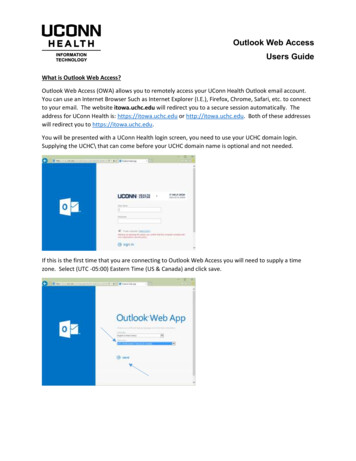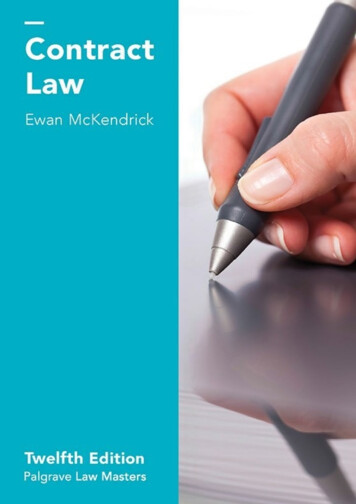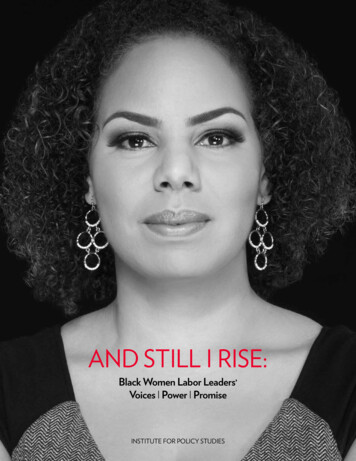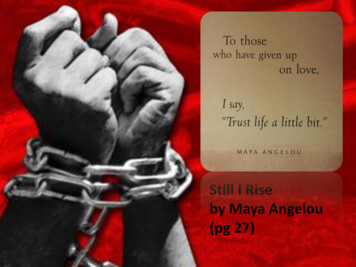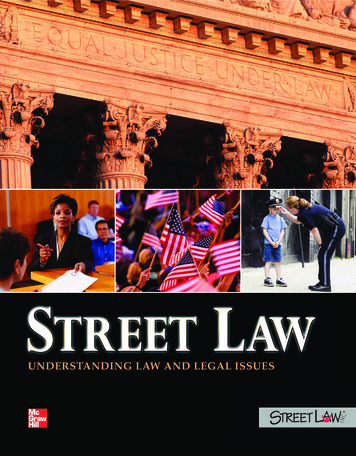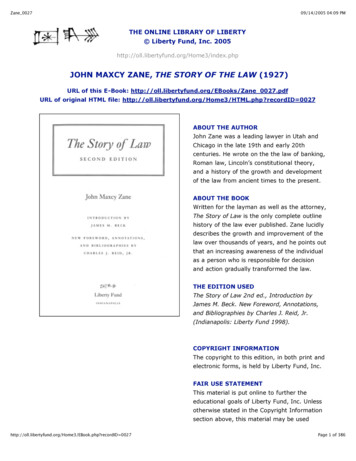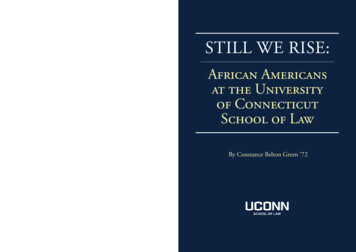
Transcription
STILL WE RISE:African Americansat the Universityof ConnecticutSchool of LawBy Constance Belton Green ’72Office of Communications55 Elizabeth StreetHartford, CT 06105-2290
STILL WE RISEAfrican Americans at the University of Connecticut School of LawPrologueStill I RiseJust like moons and like suns,With the certainty of tides,Just like hopes springing high,Still I’ll rise. (excerpt)Maya AngelouStill I Rise, a poem by Maya Angelou, inspired the title Still We Rise,African Americans at the University of Connecticut School of Law. It isa story based on historical reflections and contemporary perspectivesabout the challenges and achievements, the courage and the grit,of African American lawyers. Justice Thurgood Marshall noted thatAfrican American lawyers have a unique role in American history,not only with respect for the rule of law, but also with respect to aresponsibility to the legal system’s promise of “equal justice under thelaw.” (J.Clay Smith, Emancipation, University of Pennsylvania Press,1993) Copyright 2019 University of Connecticut School of LawAlthough the primary focus is the period between 1969 and 1979,information is included from before and after that decade. Thisaccount is derived from historical documents and alumni and facultynarratives. The information presented in the first person is from mydirect personal experience.
African Americans at the University of Connecticut School of LawIntroductionIn the fall of 1969, I was one of six young African Americans toenroll at the University of Connecticut School of Law. We werenot the first black students to attend the law school, although Iwas the first black woman. Until then, in the first 48 years of thelaw school’s existence, seven African American men had graduated.In their class photos, they are isolated in a field of white faces. Wesix, all arriving that fall at a time when no other black studentswere enrolled, represented a turning point. We were the vanguardthat would establish a lasting and continuous presence for AfricanAmericans on campus.The law school, founded in 1921 as the Hartford College ofLaw, was established as a night school to supply junior lawyers toHartford area insurance companies and banks. In 1943, in theface of plummeting enrollment brought on by World War II, itaffiliated with the University of Connecticut. By 1954, after yearsof renewed growth following the war, the University of ConnecticutSchool of Law had outgrown the mansion in Hartford where ithad been located since 1940. The American Bar Association wasrecommending that the university provide more space for a librarycollection, classrooms and faculty offices. At the same time, theuniversity’s administration was looking for ways to shed the label of“agricultural school” historically attached to the main campus in ruraleastern Connecticut. Expanding the law school and, a few years later,opening medical and dental schools in Farmington, would give theuniversity flagship graduate schools to assist in its transformation.11Newmyer, Kent, Hard Times and Best of Times: The University of Connecticut School of Law at39 Woodland Street. University of Connecticut School of Law. Hartford, Connecticut, 2016.1
STILL WE RISEAfrican Americans at the University of Connecticut School of LawConstruction began on a large brick building in West Hartfordand in 1964, the University of Connecticut School of Law movedthere. Soon afterward, Howard Sacks became dean and began to pushforward on two significant fronts. One was to attract law faculty ofnational reputation, a task complicated by the fact that, according toProfessor Colin Tait, there was hardly enough money to pay for thecandidates’ lunch. The second goal was to increase financial assistanceto law students, including support for out-of-state applicants, apriority that would also come to encompass increasing racial diversity.2Class of 1937(Thomas J. Meskill Law Library)Hesitant BeginningsIn 1969, law schools nationwide were still overwhelmingly segregatedand African Americans were vastly underrepresented in the professionof law. For its first five decades, the Hartford College of Law andthen the University of Connecticut School of Law graduated onlya handful of African Americans. The first, in 1937, was Daniel I.Fletcher, who was working at the Aetna Insurance Co. in Hartfordwhen he enrolled at the Hartford College of Law. He later becamea manager for the Hartford Housing Authority and directed agroundbreaking mediation program in the Circuit Court in Hartford.It would be another 12 years before William Graham became, in1949, the second African American to graduate from the law school,and another 12 years after that before there was a third, Paul Lewisin 1961. Alfred Rogers and E. Eugene Spear followed in 1963, andThomas West and John Billingslea in 1969.22Id.3
STILL WE RISEAfrican Americans at the University of Connecticut School of LawWilliam Graham, Class of1949, November 5, 1966(Hartford Times PhotographCollection, Hartford History Center,Hartford Public Library)Paul Lewis, Class of 1961, September 29, 1961(Hartford Times Photograph Collection, HartfordHistory Center, Hartford Public LibraryPhotograph by Morton J. Boardman)The achievements of those pioneers were exemplary. Grahambecame a Superior Court judge, Lewis opened one of the first AfricanAmerican law firms in the Hartford area, Rogers was a vice presidentat Northeast Utilities and president of the Greater Hartford UrbanLeague, Spear and West were appointed to the Connecticut AppellateCourt, and Billingslea became a captain in the U.S. Army JudgeAdvocate General’s Corps before he turned to acting and pursued asuccessful career in television and film.In 1969, no African American woman had attended theUniversity of Connecticut School of Law. Nor did any AfricanAmerican woman practice law in Connecticut, although twoprominent black female attorneys had Connecticut ties. JaneBolin graduated in 1931 from Yale Law School in New Haven,Connecticut, and became the first African American female judge inthe United States when she was appointed to the Domestic RelationsCourt for the City of New York in 1939. Constance Baker Motleywas born in New Haven, studied at Columbia Law School and was(Thomas J. Dodd Research Center)an attorney with the NAACP Legal Defense Fund when the U.S.Supreme Court decided the landmark Brown v. Board of Educationin 1954. She became, in 1966, the first African American woman inthe nation appointed to the federal bench.According to an analysis by researcher William C. Kidder,there were 2,180 African American lawyers in the United States in1960, making up 0.76 percent of the profession.3 Connecticut wasbelow that average. According to census data from 1970, there were32 black lawyers in Connecticut, 0.67 percent of the state’s total.Women made up 3.8 percent of the Connecticut bar, and none wereAfrican American.In the 1964-65 academic year, according to Kidder’s estimate,about 1.3 percent of law students enrolled in the United Stateswere African American. The American Association of Law Schoolshad made a modest attempt to address the problem in 1955 whenits Committee on Racial Discrimination proposed that “[a]ny lawschool that actually denied admission to an otherwise qualified34Alfred Rogers, Class of 1963,Undergraduate on StorrscampusKidder, William C. “The Struggle for Access from Sweatt to Grutter: A History of African American,Latino, and American Indian Law School Admissions, 1950-2000,” Harvard Blackletter Law Journal 19(2003): p. 1-42. HeinOnline, https://heinonline.org/HOL/P?h hein.journals/hblj19&i 13.5
STILL WE RISEAfrican Americans at the University of Connecticut School of LawJohn Billingslea, Class of 1969(Thomas J. Meskill Law Library)Negro could be dropped from membership in the Association.” Thatproposal, however, was blocked by some of the southern law schools.4Meaningful integration did not take hold until after a series of legalactions, including U.S. Supreme Court decisions, the passage ofthe Civil Rights Act of 1964, and federal affirmative action policiesestablished in 1965 and strengthened in 1969 by President LyndonJohnson’s executive orders.In the spring of 1969 the University of Connecticut Schoolof Law graduated two black men. One was Billingslea, a footballstandout who grew up in Meriden, Connecticut, and earned hisundergraduate degree at the University of Connecticut in Storrs.Billingslea indicated in a 2017 interview that although he didn’tfind law school particularly isolating, he did recall that he neededthe intervention of a white friend’s father to find housing in thearea of the law school. And he took it for granted that his whiteclassmates would not understand his challenges as a black man.Leflar, Robert A. “Legal Education: Desegregation in Law Schools.” American Bar Association Journal,vol. 43, no. 2, 1957, pp. 145–149. JSTOR, JSTOR, www.jstor.org/stable/25719902.“All my classmates were great guys, but when I told them about myexperiences in Connecticut in terms of discrimination, it was—theycouldn’t believe it. And I understand. If you don’t grow up this coloryou don’t know what it’s like,” he said.In 1968 debate erupted on the UConn Law campus about theabsence of black students and faculty. Two white students, JohnDziamba ’69 and Robert Farr ’69, asked in a letter to the JointStudent Faculty Relations Committee on September 16, 1968, whythere were so few black students at the law school. They pointed outthat the only black students (West and Billingslea) would graduateat the end of that academic year and the student body would be allwhite again unless more black students enrolled. Further, the lawschool had never had a black faculty member. The only black staffmember, Dziamba and Farr noted, was “in the traditional job ofcustodian.” They urged the law school to work harder to enroll blackstudents, recruit black faculty members and hire more black staff.The letter was described in an article published in the studentnewspaper, The Legal Realist, on October 16, 1968. Two days later,the newspaper published a lengthy response from Assistant DeanRonald Sampson, who struggled to explain the failure to recruit blackstudents. The law school had only six black applicants in 1968 andoffered admission to three of them, he wrote, but none accepted. Hesuggested that the reasons included strong competition among lawschools for black applicants and UConn Law’s relatively low profilenationally. Also, he wrote, “our location in an upper middle classwhite community may hold little attraction for the black studentreared in the ghetto and probably schooled at a predominately blackinstitution.”Responding at length in a letter to The Legal Realist onDecember 19, 1968, one law student saw no reason to recruit blackstudents. Suggesting that he spoke for a “non-vocal majority,” PeterD. Campbell ’70 argued that an all-white student body was consistentwith the law school’s mission as a state institution. “This is apredominately white country both culturally and socially and Negroes467
STILL WE RISEPeter Lane, Associate Dean, 1962–1982(Thomas J. Meskill Law Library)are a minority,” he wrote. “I am not alone in the world when I tellyou that I go for days at a time without any contact with Negroes.And do you know, I do not feel bad about that or the fact that I donot have a Negro professor or classmate or associate.” Campbell wascorrect in one respect—there had been minimal interaction betweenthe law school and the increasingly diverse community in nearbyHartford.The issue of The Legal Realist that carried Sampson’s explanationof minority student enrollment also contained an irritable responsefrom Assistant Dean Peter Lane to a question about the lack of racialdiversity on the law school’s staff. “If you want to criticize me for nothaving specifically requested a Negro, you can,” the newspaper quotedhim as saying. “But that is why I tried to explain the hiring procedureto you in the first place I can only interview people that are sentme by the Personnel Department in Storrs.” The university, he said,had not referred any black applicants to him. When asked aboutthe many black staff members at the university’s School of Social8African Americans at the University of Connecticut School of LawWork, he replied, “Maybe it’s because of Ray Craddock over there.He’s Assistant to the Dean. Maybe they send him all the Negroes.He’s a Negro.” Craddock replied with equanimity in an article inthe December 19, 1968, edition of The Legal Realist that recruitingblack staff required outreach. “I have found that I must actively seekout and request Black and other minority group individuals if I wantthem on the staff,” he said.As the public disagreements continued, Sampson was quietlyplanning recruitment trips to historically black colleges. During the1968-69 academic year, he visited Howard University in Washington,D.C.; Morgan State University in Baltimore; Morehouse College andSpelman College in Atlanta; and Hampton Institute (now HamptonUniversity) in Hampton, Virginia. Many of the African Americanstudents who enrolled at UConn School of Law between 1969 and1979 were actively recruited. I was among those who met Sampsonat Hampton Institute and heard his offer of a full scholarship,including living expenses, if I was admitted and enrolled. VanessaBryant ‘78, who went on to become the first black female federaljudge in New England, was persuaded by the same offer to enroll in1975. After learning she had been accepted to Georgetown, Howardand UConn, she said her decision was easy. “It was a very practicaldecision, UConn offered me a full scholarship,” Bryant said in a 2017interview. Other black students throughout the decade between 1969and 1979 have commented on the importance of scholarship fundsin making their decision to attend UConn. For example, MauriceMosley ’75, speaking at a panel discussion at the law school’s annualreunion in 2018, recalled that he had a choice between UConn andYale law schools, but UConn offered the full scholarship.In addition to the offer of scholarships, the plan to actively recruitAfrican American students to UConn Law came with a decisionto modify admission policies. In 1968 the admissions committeeauthorized a program to admit a limited number of students who didnot meet the law school’s conventional criteria, which had focusedsolely on the applicant’s score on the Law School Admission Test,9
STILL WE RISEor LSAT. Consideration would also be given to other indications ofpromise. Scores on the LSAT could be combined with grade pointaverages to give more emphasis to the academic record. Qualitativefactors, including superior recommendations, distinguishedgraduate work in another field or an unusually compelling personalbackground were added to the admissions criteria.The faculty endorsed the policy on November 5, 1969, butonly after what was described in the minutes of the meeting as a“tumultuous discussion.” There is no transcript of that discussion ora record of the vote tallies, but the minutes describe two motions,proposed and defeated, to specify that the program would not involveany racial preference. While the special admissions program wasintended to diversify the student body, it was not limited to minorityapplicants. As a 1982 internal study noted, “Some students admittedunder the special admission program are not from minority groups(e.g., Black or Spanish-speaking) and some minority students areadmitted under the conventional admissions program.” Nevertheless,the program was identified with minority applicants, and it provedover time to be a double-edged sword for the students who soughtnot only to survive law school but to thrive.African Americans at the University of Connecticut School of LawConstance Green, Class of 1972(Constance B. Green Private Collection)1969: A Turning PointI came to the University of Connecticut School of Law in 1969from Virginia. Timothy Rogers ’72 was from New Jersey, HaroldThompson ’72 was from Ohio, and Milton Thomas ’72 was fromStamford, Connecticut. Also entering in 1969, as second-year transferstudents, were Kenneth Davis ’71 and Ronald Powell ’71, who hadjust completed their first year at Howard University School of Law inWashington, D.C.Our first task was to find housing. Late in August 1969, myfather and I drove from our family home in Portsmouth, Virginia,to find a place for me to live. We had an appointment with Lane,the assistant dean, who gave us a list of rooms and third-floor atticapartments available to rent in the neighborhood surrounding thelaw school’s West Hartford campus. It seemed a safe and convenientsolution to my housing needs. My father and I knocked on the door1011
STILL WE RISEVanessa Bryant, Class of 1978, n.d.(Vanessa Bryant Private Collection)of one of the first homes on the list. We were curtly told that no roomwas available. We knocked on the front doors of several other homeson the list. We were told again and again that no room was availableor the owners had decided not to rent to a law student. Withoutsaying a word, I had only to look at the knowing disappointment inmy father’s eyes. That list had not been meant for me.It was a revelation. I had been an honor student at HamptonInstitute and an exchange student at Cornell University. I completedan independent study abroad program in Athens and Thessaloniki,12African Americans at the University of Connecticut School of LawGreece. I thought I understood how to navigate differentenvironments, including living in a culture different from my own. Ieventually found a place to live, on Collins Street in Hartford, morethan two miles from the law school. Unfortunately, the traditionof giving a list of rentals in homes to incoming students persistedfor many more years, along with the barriers that African Americanstudents encountered. Bryant, who arrived to look for housing in1975, recounted this experience:“My plan was to rent a room in a house in the neighborhood ofthe law school. I came to Hartford about a week before law schoolbegan, and I obtained the list of rooms to rent from the registrar’soffice. I proceeded to go to the houses on the list, and 100 percentof the places that I went were unavailable for a variety of reasons. Ispent two days doing that, and at the end I arrived at the home of awoman who introduced me to the director of housing for the brandnew YWCA in Hartford. I moved into the YWCA, and learned thateveryone residing at the YWCA had profound mental illnesses.”Bryant found the situation so intolerable that she called her familyand told them she intended to return to Washington and attendHoward University School of Law. But she took her grandmother’sresponse to heart: “Don’t you think this is a good time for you tolearn how to deal with racism?” She connected with other black lawstudents and found an apartment on Marshall Street in Hartford,near the place I had found on Collins Street six years earlier. Althoughshe was ultimately happy with the apartment she found, Bryant saidthe housing struggle left a mark. “It was discouraging.”Once settled into the housing we could find in 1969, we sixstudents faced other barriers and challenges. Each of us had beenacademically strong as undergraduates but felt pressure to prove toboth faculty and other students that we belonged in law school. Davisrecalled in a 2017 conversation how low the expectations were for hiswork compared with the expectations in his previous year at HowardLaw. Thomas remembered the African American students beinglabeled “special admits” or the “others.”13
STILL WE RISEWhile the special admissions program continued to stircontroversy, Dean Sacks was mild in his public comments. Heacknowledged that admissions standards had been broadened underthe new program, but added that “we expect the overwhelmingmajority will achieve high enough grades based on normal gradingstandards to move to the second year.” Behind the scenes, Sacksemerged as a quiet champion who actively supported the recruitmentof minority students and the success of every student on campus.In spite of the rocky start, by the end of the fall 1969 semester, wesix students had established an agenda. We decided to recruit moreblack law students and engage with the Hartford community. A firststep was to visit Yale Law School in New Haven, because it had moreblack law students and an established chapter of BALSA, the BlackAmerican Law Students Association. Yale Law’s first African Americangraduate had been Edwin Archer Randolph, who earned his degreein 1880 and was licensed to practice in Connecticut. However, hereturned to Virginia to set up a law practice in Richmond. GeorgeW. Crawford, a 1903 graduate who became the City of New Haven’scorporation counsel, inspired the George W. Crawford Black BarAssociation, which was founded in Hartford in 1977. One of the firstCrawford Black Bar Association presidents was Bessye W. Bennett’73. She was also the first African American woman licensed topractice law in Connecticut.In the fall of 1969, the African American students at UConnSchool of Law established a BALSA chapter with Thompson aspresident and Rogers as vice president. The organization petitionedthe university for funds to recruit more black students and toestablish a clinic in Hartford. They were awarded 7,500 to covertravel expenses for out-of-state recruitment and 1,500 to establisha clinic. “In a flurry that took most students at the law school bysurprise, Black students at this and other graduate schools of theUniversity began a campaign shortly before Christmas recess toobtain administration approval for funding Black recruiting,” TheLegal Realist reported in January 29, 1970. BALSA members teamed14African Americans at the University of Connecticut School of Lawup with students from the university’s schools of Social Work andMedicine, traveling in pairs to historically black colleges in Maryland;Washington, D.C.; North Carolina; Georgia; and Ohio.Although BALSA members were buoyed by the success of theircampaign, many white students were ambivalent about recruitingAfrican American students, and some were openly resentful. Thearticle in The Legal Realist about the recruiting trips undertakenby BALSA members stated: “Many students are known to bedisgruntled at the apparent ease with which money was obtained byblack students for black recruiting when, in their opinion, there isnot enough general scholarship aid made available to all students.”A survey taken by The Legal Realist and published on March 12,1970, found that while 71 percent of the students who respondedwere in favor of recruiting “minority groups,” 53 percent believedrecruitment should not focus on African Americans and 64 percentobjected to earmarking financial aid for black students. The StudentBar Association minutes from 1972 and 1973 mention severalcontroversies over funding for BALSA’s student recruitment efforts.After an “extensive and heated debate” on May 8, 1972, the SBAvoted to cut 1,000 from BALSA’s budget request for recruiting andtransfer it to a fund “for other students to use in the recruitment ofmembers of other minority groups.”Despite the friction, members of BALSA continued recruiting,and by May 1970, they were also involved in a cooperative campusproject. After members of the Ohio National Guard opened fire on aVietnam War protest at Kent State University on May 4, 1970, killingfour students, BALSA joined the student strikes that were shuttingdown college campuses across the nation. All UConn Law classeswere canceled and students met to strategize. Thompson led BALSAdiscussions that focused on the Kent State shootings but also coveredprotests in black communities and the effects of racial violence, suchas the 1963 bombing of a church in Birmingham, Alabama, thatkilled four black girls. On May 11 and 12, 1970, BALSA held forumsentitled “Racism at UConn Law School.” Shirley Zabel, a visiting law15
STILL WE RISEprofessor, praised the events in the May 15 edition of The LiberatedLaw Student, a short-lived student publication that focused on theanti-war movement, as having raised “provocative and profoundquestions” about the law school, legal education, the profession and“the legal process itself.”And so by the close of the 1969-70 academic year, six blackstudents had established a chapter of BALSA, had engaged activelyand directly in black law student recruitment, and had connectedwith the campus community. It was a strong foundation for theprogress that followed.African Americans at the University of Connecticut School of LawBessye Warren Bennett,Class of 1973, leaving for RadcliffeCollege (left), and as a HartfordPublic School Teacher(Dr. Vera Bennett Brown Private Collection)1970 and Beyond: Survive and ThriveIt is difficult to say with certainty the precise number of blackstudents who entered UConn Law in the fall of 1970. Many of thelaw school’s records in the 1960s and 1970s count the total numberof African American students without breaking the numbers down byclass year or conflate African Americans with other minority groups.The university’s records indicate that there were 22 minority studentsattending the law school in 1970. Rogers, who was president ofBALSA in 1971, remembers that about 12 minority students arrivedin 1970 and another 10 in 1971.Among those arriving in 1970 was Bennett. She was a trailblazer,having entered Radcliffe College at the age of 16 after graduatingas valedictorian from Yates High School in Houston. In 1958 shegraduated with honors and was accepted to Harvard Law School. She1617
STILL WE RISEdeferred admittance, however, to marry her college sweetheart, JohnBennett, a doctoral student in mathematics at Harvard University.They moved to Hartford and Bessye Bennett became a teacher inthe Hartford Public School System. She enrolled at UConn Lawin 1970 to fulfill her dream of becoming a lawyer, even as she andher husband raised three school-age children. In 1995 she sat for aninterview (which also included me and Patricia Lilly Harleston ’74)with the Connecticut Law Tribune. Recalling her time at UConnLaw, Bennett said there were still so few African American studentsthat they were regarded as a curiosity. But minuscule as it was, thepopulation of black students was growing at a time of other changeson campus. More women were enrolling, anti-war protests werebuilding and students were questioning faculty more sharply. It wasalmost as if it was too much for the faculty and some students toassimilate, Bennett said, although ultimately she thought “the classcoped very well.”Howard Brown ’73, a graduate of Morehouse College in Atlantawho arrived the same year as Bennett, recalled his activism as a firstyear law student, including anonymously putting flyers of protestunder some professors’ office doors. He further recalled being oneof the first black students to work with the student newspaper, TheLegal Realist.Linda Kelly ’76 arrived at the law school as a second-year transferstudent from California. Born in North Carolina, she wanted tofinish law school on the East Coast. She recalled that a lot of herlaw school experiences related to the fact that she was an EveningDivision student and worked full-time at Hartford National Bank.She later commented, “I don’t know if I ever looked to fit in becauseit wasn’t something that happened. You dealt with the cards you weredealt. You dealt with life as you found it, and you made a way to dothe best that you could do with the situation.”On October 26, 1970, BALSA members teaming up withstudents from the schools of Medicine and Social Work opened aclinic in the basement of the Warburton Community Church at18African Americans at the University of Connecticut School of LawLinda Kelly, Class of 1976, n.d.(Linda Kelly Private Collection)Flatbush and Brookfield Avenues in the city’s Charter Oak section,offering “one stop legal, social and medical services” to Hartfordresidents. The clinic operated for a year and a half before studentsconcluded that it was too time-consuming to continue.The law school was just a mile and a half from the Hartfordborder, but it was a line that separated two communities with vastlydifferent demographic profiles. By 1960, nearly 25,000 AfricanAmericans were living in Hartford, about 15 percent of the city’spopulation, and by 1970 there were about 44,000, nearly 28 percentof the city’s population. In contrast, the 1960 census reported 229African Americans in West Hartford, comprising 0.3 percent of thepopulation. By 1970, only 1.3 percent of the population of HartfordCounty outside the City of Hartford was African American.19
STILL WE RISEPicketers in front of Noah Webster School,West Hartford CT, April 15, 196u(Hartford Times Photograph Collection,Hartford History Center, Hartford Public Library)As Professor Stacey Close of Eastern Connecticut State Universitydescribed that period in a 2001 article, members of the growingblack community in Hartford began to assert themselves more firmlyas the 1960s progressed. Their efforts consisted mainly of peacefulrallies and marches to protest widespread discrimination in housing,education and employment. Decades of patient, non-confrontationalstrategy had brought some incremental progress, including theestablishment of a city Human Rights Commission in 1963, butthe pace was slow. As race riots spread across the country in 1967, arelatively minor incident in Hartford’s North End blew up. A youngblack man was arrested, accused of using vulgar language to a waitressAfrican Americans at the University of Connecticut School of Lawin a black-owned luncheonette. Three days of riots ensued, with afirebombing and damage to both black- and white-owned businesses.5Later that year, the Hartford branch of the National Associationfor the Advancement of Colored People led a march to protestdiscrimination in housing. Police stopped the
Maya Angelou Still I Rise, a poem by Maya Angelou, inspired the title Still We Rise, African Americans at the University of Connecticut School of Law. It is a story based on historical reflections and contemporary
